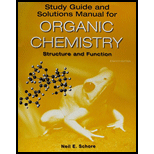
(a)
Interpretation: The structure of the enantiomer of the arabinose needs to be drawn.
Concept Introduction: Enantiomer has an opposite configuration about the chiral atom.
(b)
Interpretation: The other enantiomer needs to be drawn.
Concept Introduction: Enantiomer has just opposite configuration about the chiral atom.
(c)
Interpretation: The structure of diastereomer of arabinose needs to be determined.
Concept Introduction:Diastereomer has the same configuration but opposite configuration about chiral atom.
(d)
Interpretation: The number of other diastereomer needs to be determined.
Concept Introduction:Diastereomer has just opposite configuration about chiral atom, rest configuration will be same.
(e)
Interpretation:The rotation of the structure needs to be determined.
Concept Introduction:Rotation is defined as an angle how much the group is rotated about chiral atom of the molecule.
(f)
Interpretation: The rotation of diastereomer needs to be determined.
Concept Introduction:Diastereomer has rotation about chiral atom only.
(g)
Interpretation: The optically inactive diastereomer needs to be explained.
Concept Introduction:If a diastereomer has a plane of mirror then it is optically inactive.
Want to see the full answer?
Check out a sample textbook solution
Chapter 5 Solutions
EBK STUDY GUIDE/SOLUTIONS MANUAL FOR OR
- pls help asaparrow_forward9. Consider the following galvanic cell: Fe (s) | Fe(NO3)2 (aq) || Sn(NO3)2 (aq) | Sn (s) a. Write an equation for the half reactions occurring at the anode and cathode. b. Calculate the standard cell potential Show all of your work. c. Draw and label the galvanic cell, including the anode and cathode, direction of electron flow, and direction of ion migration.arrow_forwardpls help asaparrow_forward
- 11. Use the equation below to answer the following questions: 2 Al(s) + 3 Cd(NO3)2 (aq) → 2 Al(NO3)3 (aq) + 3 Cd(s) a. What is the net ionic equation for the reaction? b. Which species is a spectator ion in this reaction? Define a spectator ion. c. Identify the oxidizing agent and the reducing agent.arrow_forwardpls help asaparrow_forwardpls help asaparrow_forward
- PLEASE READ!!! I DONT WANT EXAMPLES, I DONT WANT WORDS OR PARAGRAPHS FOR THE MECHANISM!!! THANKS First image: QUESTION 6. I have to show, with ARROWS and STRUCTURES, the mechanism of the reaction at the bottom. Also I have to show by mecanism why the reaction wouldn't work if the alcohol was primary. I also tried to draw the mechanism, tell me what to change. Please note that its an AMIDE thats formed not an AMINE the nitrogen has ONE hydrogen and one Phenyl-C-Phenyl. I already asked for this mechanism and got as a final product ...-NH2 not whats shown on the picture, thank you Ths second part. QUESTION 3. I just need a way to synthesize the lactone A, I already started please continue from where I left it Second image: I simply need the products, substrates or reagents, thank youarrow_forwardIndicate how to prepare a 10% sodium hydroxide (NaOH) solution to a slightly alkaline pH.arrow_forwardCH, CH CH₂ CH₂ Phytyl side chain 5. What is the expected order of elution of compounds A-D below from a chromatography column packed with silica gel, eluting with hexane/ethyl acetate? C D OHarrow_forward

 Organic ChemistryChemistryISBN:9781305580350Author:William H. Brown, Brent L. Iverson, Eric Anslyn, Christopher S. FootePublisher:Cengage Learning
Organic ChemistryChemistryISBN:9781305580350Author:William H. Brown, Brent L. Iverson, Eric Anslyn, Christopher S. FootePublisher:Cengage Learning

